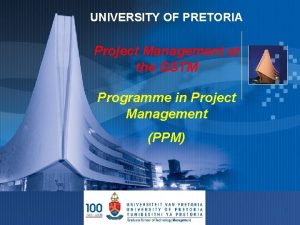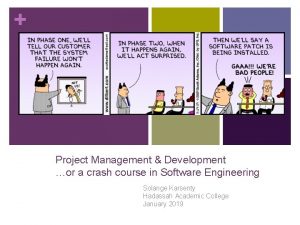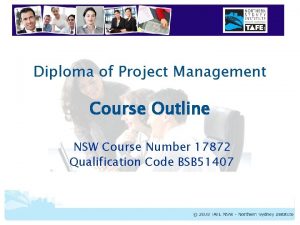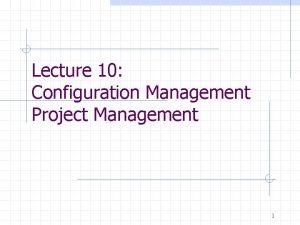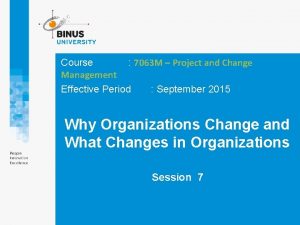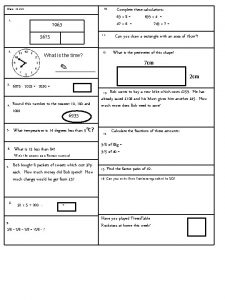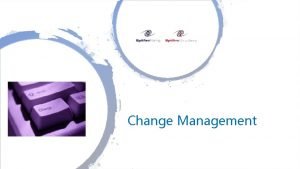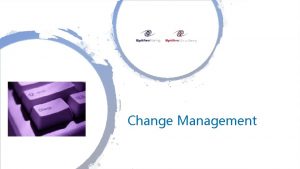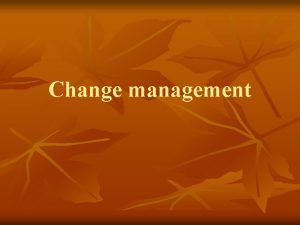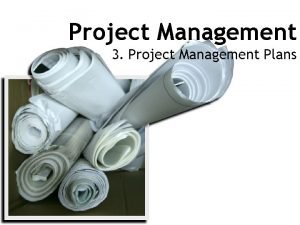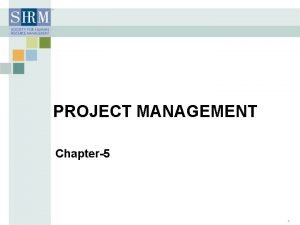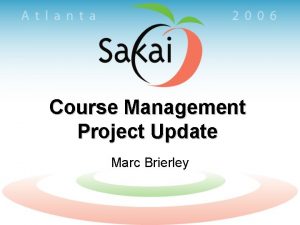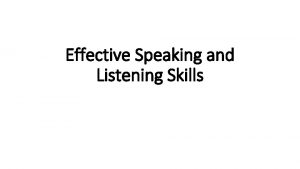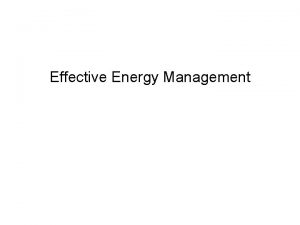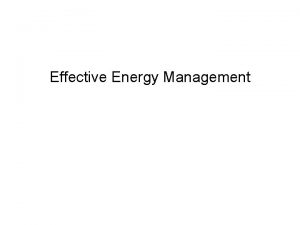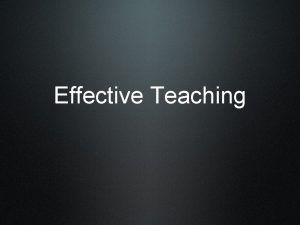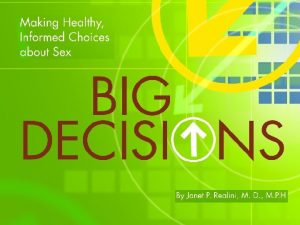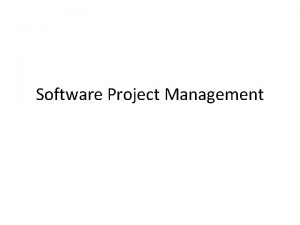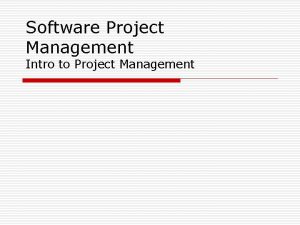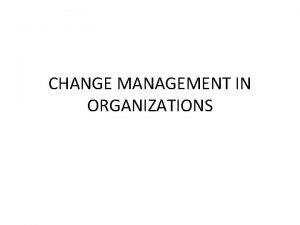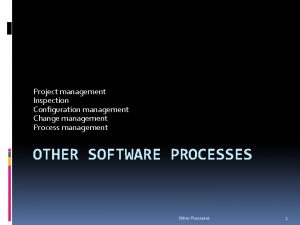Course 7063 M Project and Change Management Effective




































- Slides: 36

Course : 7063 M – Project and Change Management Effective Period : September 2015 Linking Vision & Change and Communicating Change Session 9

Acknowledgement These slides have been adapted from: 1. Nelson and Coxhead, 1997 2. Clampitt, De. Koch and Cushman 2000

Learning Objectives Explain why organizations change and what is change management

Contents v. What is Vision v. Linking Vision to Change v. The Communication Process and Strategies v. Communication Media v. Skills for Communicating Change

Definition of Organizational Vision § A statement of purpose determined by management based on organization’s core values and beliefs that defines the organization’s identity and combined an ideal manifestation of its directions together with a tangible prescription for realizing its goal (Landau, Drori and Porras, 2006) § It’s a snapshot description of desired future state you want to work toward (Duke Corporation Education, 2005) § An ambition about the future, articulated today; it is a process of managing the present from a stretching view of the future (Stance and Dunphy, 2001) § A detailed description of a desired future that provides clarity as to how the organization will need to operate differently in order to meet the changing conditions of its markets, customers, and overall business environment (Belgard and Rayner, 2004)

Sample Visions Company Vision Du. Pont Our vision is to be the world's most dynamic science company, creating sustainable solutions essential to a better, safer and healthier life for people everywhere Good Year Become a market-focused tire company providing superior product and services to end users and to our channel partners, leading to superior returns for our shareholders Borders Group To create richer, more satisfying lives through knowledge and entertainment Kraft Foods Helping people around the world eat and live better P&G Be, and be recognized as, the best consumer products and services company in the world Nokia Our vision is a world where everyone can be connected Gen. Electric We bring good things to life Sara Lee To be the first choice of consumers and customers around the world by bringing together innovative ideas, continuous improvement, and people who make things happen

Vision § Having a vision is often linked to why successful organizational change is achieved § Conversely, lack of vision is frequently associated with organizational decline § The role of vision in producing organizational change is linked to the image one has of managing change § Vision is commonly thought of as a guide for the organization in identifying the appropriateness of particular changes that are proposed

Vision has Three Components For Pendlebury, Grouard, and Meston: 1. Why the change is needed the problem It helps to validate the need for change 2. The aim of the change the solution It helps to gain appreciation of the gap between the organization’s current state and envisioned future 3. The change actions that will be taken the means It is how change actions will be mobilized and delivered

Characteristics of Good Vision For Kotter (1996) § Imaginable – it conveys picture of what future will be § § Desirable – it appeals to long term interests of stakeholders Feasible – it embodies realistic, attainable goals Focused – it provides guidance in decision making Flexible – it is general enough to enable individual initiative and alternative responses to changing environments § Communicable – it can be explained in five minutes Scott-Morgan et al § Aspiration – how the new organization will look § Inspiration – getting people excited about where they are headed § Perspiration – helps highlight the work that needs to be done to achieve the vision

Visions Compare to Mission, Goals and Strategy How Does Vision Compare to …. The Difference is ……. . Mission depicts what the organization is and does …. . not where it is headed in the future Philosophy articulates values and beliefs about how work should be carried out …. . without prescribing what the future will look like Goals and Strategy Goals and strategy statements define specific outcomes. They articulate hoe the organization will progress toward the future …. not what the actual future will be

Vision and Mission of BINUS University (1 of 4)

Vision and Mission of BINUS University (2 of 4) Vision: “A World-class university … In continuous pursuit of innovation and enterprise” Key words What we mean by: World Class University Graduates of UBINUS will be accepted in the global market and environment through the highest level of education excellence encompassing teaching, learning and applied research Innovation The economically successful introduction and application of new and existing scientific knowledge and teaching-learning process for practical purposes in order to create superior stakeholder value Enterprise Innovative business practices relating to an individual or organization’s capability to drive positive changes in the global market and environment Source: http: //www. binus. ac. id/About. Us/Vision. and. Mission/English

Vision and Mission of BINUS University (3 of 4) Mission The mission of BINUS University is to contribute to the global community through the provision of world-class education by : § Recognizing and rewarding the most creative & value-adding talents § Providing a world-class teaching, learning and research experience that fosters excellence in scholarship, innovation and entrepreneurship. § Creating outstanding leaders for global community § Conducting professional services with an emphasis on application of knowledge to the society § Improving the quality of life of Indonesians and the international community Source: http: //www. binus. ac. id/About. Us/Vision. and. Mission/English

Vision and Mission of BINUS University (4 of 4) Value § Tenacious Focus Acting with a passionate, committed, and determined focus towards shared purposes. § Freedom to Innovate Combining integrity with a creative and result-oriented spirit § Farsighted Sharing the foresight to recognize and take action on future opportunities § Embrace Diversity Celebrating diversity in the pursuit of excellence Source: http: //www. binus. ac. id/About. Us/Vision. and. Mission/English

Context Affects Vision Change Susceptibility Hi Lo Bold Organizations (low resources, high acceptance, organic) Rigid Organizations (low resources, lack of acceptance, hierarchical) Lo Bina Nusantara Liberated Organizations (high resources, high acceptance of the need for change ) Over managed Organizations (high resources, low acceptance, dominated by past practices ) Resource Availability Hi

Processes by which vision emerges There a number of approaches to creating vision which include: §Crafting the vision: this can be either Telling/Selling, Testing/Consulting, Co-creating §Questions that help to develop a vision: this can be done through an intuitive, analytic or benchmarking approach §Connecting the vision to the organization’s inner voice: this connects the vision to the underlying values and beliefs that are held within the organization.

When Visions Fail (1 of 2) Change visions may fail when the objective is: § Too specific – there is always a degree of uncertainty with its customers § Too vague – fails to act as landmark toward which various change actions are directed § Inadequate – only partially addresses the problem § Too unrealistic – it is perceived unachievable by staff Visions also can fail when: § Blurred – no clear future of the future § § § Rear view mirrors – pictures of the past, extrapolated into the future Too complex – too difficult to understand Irrelevant – picture is clear, but not strongly attached to the business

When Visions Fail (2 of 2) § The walk is different from the talk – vision just a slogan § It is treated as holy grail – unrealistic expectations, or treated as magic solution to all organizational problems § It is too disconnected from the present –need to recognize current obstacles to be seen as achievable and believable. § Too abstract or too concrete– vision must be idealistic, realistic, and tangible § Developed without using a creative process – process and final result are both important § Little participation – consensus building is needed § Complacency – seen as too far into the future, not as urgent

Does Vision Drive Change or Emerge During Change? Vision Drives Change Ø Kanter, Stein and Jick: § Without a vision, change introduced may seem arbitrary and unneeded § Vision provides clarity about the goals in introducing a change § Vision helps to motivate staff in working toward the change. Ø Pendlebury, Grouard and Meston: § Vision outlines the extent of change (how it will be, how long it will take and which domain it will operate) § Having a vision at the start of change is needed for both transformational change as well as incremental or adaptive change Vision Emerges During Change § § It is not possible to articulate early on during change Organizational structures and management processes may need fundamental change and it is only after this process has begun that vision may be developed

Does Vision Help or Hinder Change? Vision Helps Change § Enhancing performance – visionary companies were likely, over time, to deliver a greater dividend to shareholders compared to other § Facilitating organization change – providing a roadmap to facilitate the transition process § Enabling sound strategic change – plans with future imagery are more likely inspire people to action § Recruiting need talent – attracted the gen X who want to maximize their income and engaging in more challenged companies § Focusing on decision making – helps develop distinctive competencies that characterize the organization Vision Hinders Change This can occur when visionary or charismatic leaders use an emotional appeal as the basis for engaging in change actions and neglect the necessary attention to operational detail needed to make the change work

Keys to developing an effective Vision 1. Senior managers need to take the lead in developing vision, but the members of the organization need to be involved 2. Vision should fit the unique situation of the organization and cannot be copied or borrowed from others. 3. Vision need to set high aspirations for the organization so that members feel that they have challenging but reachable goals. 4. Vision need to focus on how an organization will win in the future, what its outstanding products and services will be, and how they will satisfy the customer. Bina Nusantara

Keys to developing an effective Vision 5. Vision need to reflect the values that will guide how the organization accomplishes its goals and mission, and allow employees to identify with the way the organization operates. 6. Vision must communicate a sense of direction and stimulate discovery of what the organization can do and what works in particular business environments. 7. Vision must provide all employees with a sense of where it is trying to go. 8. The org. leaders should identify the kinds of capabilities that are needed, communicate them through vision statements and develop commitment to them throughout the organization. Bina Nusantara

Importance of Communication During Change § A KPMG survey of managers in 131 of Canada’s top corporations – communication as the most important factor in achieving successful changes such as mergers, downsizing and reengineering § A survey of 410 top managers in Fortune 1000 firms found that “clear and consistent communication” was deemed to be integral to achieving successful organization change § A Wyatt Company study of CEOs in 531 U. S. organizations found that if they had their time over again in going through a major restructuring, they would have focused more on communication with their employees § In Beer and Eisenstat’s in-depth study of 12 companies engaged in strategic change, they categorized 10 of them as having poor vertical communication leading to cynicism in staff and perception that there was a lack of openness by senior management about the change § In Lewis’ survey of change implementers, she concluded that communication was ranked as among the most problematic issues that they had to deal with

A Model of Communication and Principal Components Message Noise Feedback Channel Sender/receiver Encoding/decoding Sender/receiver Source: Nelson and Coxhead, 1997

Potential Problems During Communication Process § Message overloaded – when information acquisition is overbalance compared to an individual’s response capabilities § Message distortion – when meanings are misinterpreted through intentional or unintentional problems relating to the sending or receiving of the message § Message ambiguity – need when an organization has a vision but is not clear on how to achieve it.

Communicating for Change 1. Explain how change will unfold: § § What is it? How will it affect me? 2. Discuss the need for change: § § § The context Who decided in the need for change Why the status quo cannot continue 3. Establish the business case for change: § § Describe the future Out line the benefits to the organization, work unit, specific individuals 4. Determine the plan for change § § What are the new roles, expectations, responsibilities, skills, and performance measures? How will the organization support individuals to help them adapt to and achieve these changes?

Communication Strategy Continuum Underscore & explore Communication effectiveness High Low Tell & sell Spray & pray Great Identify & reply Withhold & uphold Little Amount of information transmitted Source: Clampitt, De. Koch and Cushman 2000

Contingency Approaches to Communication Strategy Two versions of communication strategies: q Communicating Strategy Depends on the Type of Change q Communicating Strategy Depends on the Stage of Change

Communicating Strategy on the Type of Change § Developmental or incremental transitions: o Widespread involvement and emphasis face to face communication as well as use of change teams to identify initiatives and broaden commitment § Task focused transitions: o Primarily top down with greater emphasis on formal communication processes such as e-mail broadcasts, memos, etc § Charismatic transformations: o Seek to gain emotional commitment to a new way of proceeding and more personalized forms of communication with two-way com. media § Turnarounds: o Occurs at times of organizational crises; formal and top down modes of communication that force people to comply with the new direction

Communicating Strategy on the Stage of Change § Commanding style – leaders are performance and result oriented; directing people toward various tasks § Logical style – leaders explain such as why a particular change is needed and what the long term goals are § Inspirational leadership – leader develops a vision of the future and encourage cohesiveness of organizational members and creating trust § Supportive leadership – leader is concerned with creating consensus and open working environment; involvement is the main commun. process § § § Planning stage logical and inspirational leadership styles Enabling stage logical, inspirational and supportive styles Launching stage logical and commanding styles Catalyzing stage inspirational and supportive leadership styles Maintaining stage inspirational and supportive communication styles

8. Vision and Changes v What is Vision v Linking Vision to Change v The Communication Process and Strategies v Communication Media v Skills for Communicating Change

Media Richness Hierarchy Highest Physical presence (face to face) Interactive media (telephone, electronic media) Media Richness Personal static media (memos, letters, tailored computer reports) Lowest Impersonal static media (flyers, bulletin, generalized computer reports) Source: Lengel and Daft, 1998

Who is Responsible for Communicating the Change? § A common view is that CEO should be personally involved in the communication of change in order to show their commitment to it; they should not delegate this activity to others in organization § A differing position is that supervisors are the best to conduct since they are more likely to be trusted by staff; preferable in face to face media § The meeting should not occur in large groups but should be more strategic, especially involving frontline supervisors § The supervisors will be in contact with frontline staff and be better able to communicate with them about the change § Two-stage strategy for briefing supervisors during a major change: 1. Round One: Seek opinions and recommendations of supervisors 2. Round Two: Reporting back to supervisors

Communication skills for Engaging Others in the Change Process (1 of 2) § Listening : o Suspending judgment - to produce an open atmosphere of trust o Identifying assumptions – to reveal misunderstanding o Listening – to enable learning o Inquiring and reflecting – for new collective understanding to emerge § Telling Stories o To keep the organization from repeating historically bad choices and to invite the repetition of past successes o Story telling can be a useful tool for manager trying to cope with rapid change

Communication skills for Engaging Others in the Change Process (2 of 2) § Selling Change Upward o Presenting : • Linking the idea to the logic of business plan • Raising the proposal continuously • Packaging the issue incrementally so that the size of change dose not appear to be too large o Bundling: linking to other ideas and issues • Profitability • Market share § Toxic Handlers o Listening emphatically o Suggesting solutions o Working behind the scenes • Organizational image • Concerns of key stakeholders • Carrying the confidence of others • Reframing difficult messages

References • Ian Palmer; Richard Dunford; Gib Akin. (2009) ”Managing Organizational Change: A Multiple Perspectives Approach” 2 edition, Mc. Graw-Hill/Irwin; Chapter 9, 10 and 11 • http: //www. urmia. org/library/docs/crc-p 3. pdf
 Traditional vs modern project management
Traditional vs modern project management Draw and describe management spectrum
Draw and describe management spectrum Project management university of pretoria
Project management university of pretoria Project management crash course
Project management crash course Bsb51407
Bsb51407 Software project objectives
Software project objectives Course title and course number
Course title and course number Stretcher bond t junction
Stretcher bond t junction Course interne moyenne externe
Course interne moyenne externe The role of project management in achieving project success
The role of project management in achieving project success Modern process transitions in spm
Modern process transitions in spm Reducing project duration examples
Reducing project duration examples Modern project management began with what project
Modern project management began with what project Project evaluation in software project management
Project evaluation in software project management Perpetual project closure
Perpetual project closure Microsoft project agile template
Microsoft project agile template Project termination types
Project termination types Chemical change examples pictures
Chemical change examples pictures Absolute change and relative change formula
Absolute change and relative change formula Difference between physical change and chemical change
Difference between physical change and chemical change Supply and demand curve shifts
Supply and demand curve shifts What is example of physical change
What is example of physical change Rocks change due to temperature and pressure change
Rocks change due to temperature and pressure change Whats the difference between physical and chemical change
Whats the difference between physical and chemical change First and second order change in education
First and second order change in education Measures of effective teaching project
Measures of effective teaching project Asset management vs project management
Asset management vs project management Configuration management in project management
Configuration management in project management Cost management principles
Cost management principles Configuration item identification
Configuration item identification Project integration management
Project integration management Investment analysis and portfolio management course
Investment analysis and portfolio management course Concept of retail management
Concept of retail management Examples of physical changes
Examples of physical changes What are integer numbers
What are integer numbers Change in supply vs change in quantity supplied
Change in supply vs change in quantity supplied Enagic compensation plan
Enagic compensation plan


